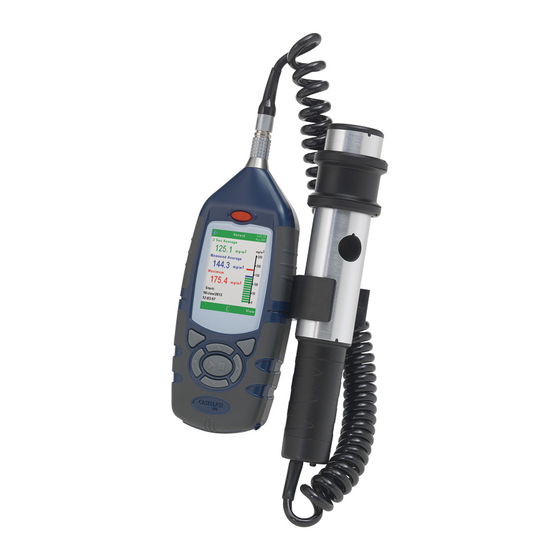
Table of Contents
Advertisement
CEL-712 Microdust Pro
Real-time Dust Monitor
HB4048-01
User Manual
CASELLA MEASUREMENT
Regent House,
Wolseley Road,
Kempston, Bedford,
MK42 7JY, U.K.
Phone: +44 (0) 1234 844 100
Fax: +44 (0) 1234 841 490
E-mail: info@casellameasurement.com
Web: www.casellameasurement.com
CASELLA CEL Inc., a subsidiary of IDEAL Industries, Inc.
415 Lawrence Bell Drive,
Unit 4
Buffalo,
NY 14221 U.S.A
Toll Free: (800) 366-2966
Tel: (716) 276-3040
Fax: (716) 276-3043
Email:
Info@CasellaUSA.com
Web:
www.casellausa.com
Advertisement
Table of Contents

Summarization of Contents
Introduction
Structure of this User Manual
Explains the manual's organization and navigation features.
Safety
Details crucial safety precautions and warnings for instrument operation.
Features and description
Principle of operation
Explains the light scattering technology used by the dust monitor.
Display screen groups
Describes the color-coded screen interface for user navigation.
Connections
Details the instrument's ports for power, USB, and output signals.
Quick reference
Providing power for the instrument
Covers battery, AC adapter, and USB power options.
How to fit the measurement probe
Guides on connecting and disconnecting the sampling probe.
Using the controls
Explains the function of keys like Soft keys, Navigation, and Run/Stop.
How to follow the operating instructions
Illustrates how to interpret screen images and navigate instructions.
Switch-on
Steps to power on the instrument and view initial information.
Set the instrument's display language
Instructions for changing the language displayed on the instrument.
Set the time and date
Procedure for setting the instrument's internal clock.
Setup
Configuration options including particulate type and data logging.
Set the display backlight
Adjusting backlight settings like activation, duration, and brightness.
Alarm and analogue output settings
Configuring alarm thresholds and analogue output parameters.
Checking the instruments Zero and Span
Guides on performing zero and span checks for accuracy.
Making a measurement Run
Measurement types
Explains the different readings available: Max, Avg, Scrolling Graph.
Starting a measurement Run
Steps to initiate and begin data logging for a measurement.
Viewing stored Runs
How to access and review past measurement data on the instrument.
Deleting stored Runs
Procedure for clearing memory to make space for new runs.
Insight Data Management Software
Installing and starting the Insight Data Management Software
Guide to installing and launching the software for data analysis.
Sampling accessories
Sampling Adapters (PUF Size Selective and Gravimetric TSP)
Details on adapters for gravimetric and PUF sampling.
Specifications
Instrument specification
Technical details including sensing, ranges, resolution, and power.
Displayed values
Explains the meaning of rolling average, measurement average, and max value.
Data logging
Information on internal memory, logging interval, and recorded values.
Optional accessories
List of available accessories for the instrument.
Standards compliance
Lists the EMC and safety standards the instrument meets.
Maintenance and servicing
Lens contamination
How to clean the instrument's optical lenses to maintain accuracy.
General maintenance
Routine care and cleaning of the instrument's exterior and components.
Servicing hints
Troubleshooting common faults and possible causes/solutions.
Servicing and warranty arrangements
Inspection and test
How the instrument is tested before shipment for quality assurance.
User servicing
States that no user-serviceable parts exist and warns against opening.
APPENDIX - Serial Communication Interface
Command set for remote control
Details commands for interrogating and controlling the instrument remotely.


Need help?
Do you have a question about the Microdust Pro and is the answer not in the manual?
Questions and answers